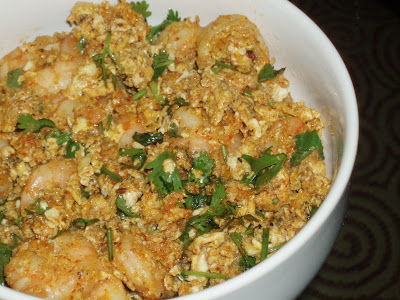
Now, before anyone can indignantly wonder how the versatile aloo (potato) can be dumb, please rest assured that it’s a transferred epithet – I’m the dumb one when it comes to gravies – too lazy for the great South Indian thickener, coconut, that I rarely use, somewhat lazy when it comes to other grinding and processing, and clueless when it comes to shortcuts to achieve the same effect, but this is so simple and seems a handy formula to employ whenever I need a gravy, whatever the vegetable! And what’s more, as the title tells you, it’s oil-free!
I didn’t think I’d make it to this JFI hosted by Vaishali of Happy Burp, but wanted to try my grandmom’s recipe – in my home, and I’m sure in yours as well, certain dishes were made only for the night, certain only for the morning. Well, my grandmom’s night potato recipe was often a light curry of tomato gravy, and her lunch recipe was a heavier curds/yoghurt kurma.
I knew the kurma would take some detecting as my grandmom’s not around now to give me the recipe and I wasn’t too keen on the tomato gravy as I hate how the skins separate from the fruit and roll into long, triangular bits and float in the curry (and I didn’t know the technique to avoid that except to blanch and puree the tomatoes, which I’m not going to do for the love of anyone), so I pretty much told myself I wouldn’t put up anything for Jihva – till I chanced upon this recipe in this little book of Oil-Free Cookery by Satarupa Banerjee (Rupa & Co, 2003).
And what a discovery it was! The smell and look pre-masala-sprinkling brought back memories of that dinner recipe my grandmom would make, and gave me the base for gravies with other vegetables.
Now, about dum aloo – I’ve been scouring the Net for the history of this dish – there are as many recipes as there are potatoes – there’s a Kashmiri version, a Bengali version, a Benarasi version, a Lucknowi version, a Hyderabadi version, and who knows, maybe a Chettinad version as well! (It may then be called urulaikizhangu kulambu, or equally painstakingly in Telugu, bangaaladumpala pulusu/koora – in Telugu, ‘dumpa’ means root/tuber, and I assume the prefix ‘bangaala’ refers to Bengal. Pulusu refers specifically to a tangy gravy and less specifically to a wet dish.)
A friend in school, a Bengali-phile, would always mention this dish. “Aloo dum,” she’d cry, raising her hand enthusiastically, probably when we were discussing favourite foods. All of us in that charming small town of our childhood would stare uncomprehendingly, wondering what on earth it was, and she’d launch into how she was more Bengali than Telugu because her granddad worked in Bengal. The memory, buried deep all these years, comes back to me as I write.
When I got my first Kashmiri recipe book, aloo dum took on a totally different colour. Literally. Without ambling over to check my cookbook rack, I remember having to saute red chilli powder and perhaps a bit of curds in oil, a pinch of dry ginger and aniseed (saunf) and then putting in baby potatoes to make a thin, brilliant, red gravy.
This evening, I even saw a recipe that involved gouging a hole in the spuds, filling them with pista and walnut and making an aloo dum of them – uber Kashmiri? Not sure, it sounded fascinating, but calorific and tiring. So without further ado, here’s oil-free, fuss-free, cooking-for-dummies aloo dum(b) my way, it requires even less work than the book prescribes – no pastes/powders to be ground, just some peas to shell.
Potatoes, scrubbed, peeled, quartered – 5, medium size
Curds/Yoghurt - 3-4 tbsp
Shelled peas – 1 cup
Ginger – 1 inch, minced/mashed
Garlic – a few cloves, mashed roughly
Onion – 1 medium, chopped
Tomato – 1 medium, quartered
Green chilli – 1 (I used a bit of red chilli paste since I had that)
Turmeric – a pinch
Salt – to taste
Bay leaves – 2
Coriander seed/Dhania powder – ¾ tsp
Garam masala/Curry powder – to taste
Beat the curds. Mix potatoes, curds, salt, peas, ginger, onion, chilli and turmeric. Let it keep for an hour.
Then, heat a cup of water in the pressure cooker/pan. Add tomatoes, garlic and bay leaves. Cook till the tomatoes are soft.
Add the potato mixture, close the pressure cooker, and once the steam emerges from the vent, put the weight on it. After it hisses once, put it on simmer and cook for about 8 minutes.
*The cooker will hiss a couple of times but don’t switch it off in a hurry. (For those using pans, I would recommend a little more water and simmering the dish with a lid on.)
Once the steam escapes on its own (without you fiddling with the weight), remove the weight, check the consistency of the gravy and cook down till it’s as thick as you like.
*You can even crush a few pieces of the potato in the gravy to thicken it.
Finally, add the curry powder and the coriander powder. Check the seasoning and adjust it to your taste.
Finish off with a garnish of coriander leaves. Goes well with rice and breads.
Enjoy!
Tags: Potatoes Tomatoes Peas Gravy Gluten-free Oil-free





